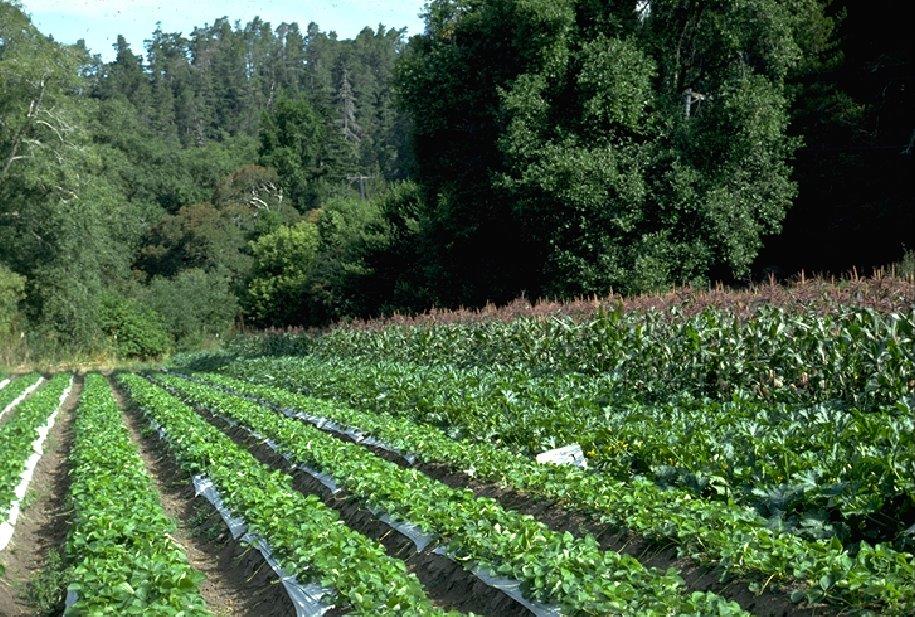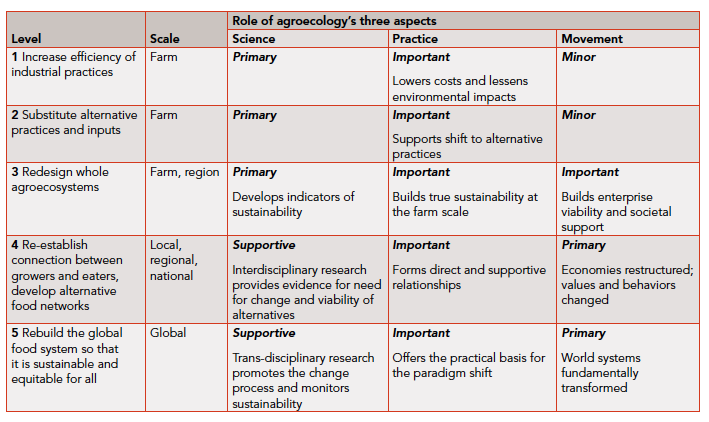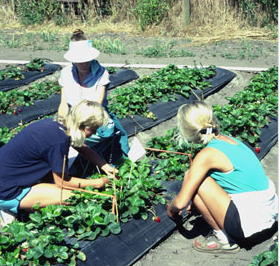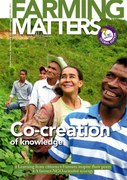Professor Steve Gliessman and farmer Jim Cochran are among the movers and shakers of the strawberry sector in California. Since the 1980s they have been experimenting with sustainable ways to grow strawberries and with alternative food networks. Committed to the agroecological transition, they built a powerful farmer-researcher partnership that was groundbreaking for farmers, academia and the strawberry industry as a whole.

The central coast of California, with its Mediterranean climate, is an important strawberry growing region. Strawberry production here, as in many other locales, is highly dependent on expensive, energy-intensive, and environmentally harmful off-farm inputs. The current system of industrial, conventional strawberry production in California can be traced back to the early 1960s. Before that time, growers treated strawberries as a perennial crop, rotating each field out of strawberries for several years. However, when the soil fumigant methyl bromide (MeBr) was introduced in the 1960s, growers started to manage strawberries as an annual crop, planted year after year and fumigated with this pesticide on the same piece of land. In the early 1980s, as interest in organic food became a potential market force in agriculture and issues of pesticide safety and environmental quality came to the fore, farmers began to respond. For 30 years, the University of California, Santa Cruz has been working with farmers to study this process.
In this context, a particularly fruitful partnership emerged between the two of us: an academic (Steve Gliessman) and a strawberry farmer (Jim Cochran). It was serendipitous that Jim’s first plantings at Swanton Berry Farm in Davenport, California were just over the fence dividing his field from the home Steve was living in at the time. Over that fence our talk about the transition to organic strawberry production led to the first side-by-side comparative trial. At Jim’s farm, our thinking and our practices evolved, using his land, varieties and practices, his workers, and many of his resources.
This article tells the story of our journey of co-creation. From this collaboration, grounded theory about levels in the transition process to sustainability emerged as our thinking evolved. We believe these levels provide useful insight into how to scale out or scale up the agroecological transition process, as well as insight into the changing role of science (see table).

Level 1: Input reduction
Even before our partnership began, extensive research was carried out to discover more effective ways of controlling pests and diseases so that industrial inputs could be reduced and their environmental impacts lessened.
Level 2: Input substitution
During the first few years of our farmer-researcher partnership, which began in 1986, we worked together in a comparative trial of strawberries going through the 3-year conversion process required for organic certification. Jim was growing strawberries using conventional inputs and management side by side with strawberries grown under organic management. In the organic plots, each conventional input or practice was substituted with an organic equivalent. For example, rather than control the two-spotted spider mite with a miticide, beneficial predator mites (Phytoseiulis persimilis) were released into the organic plots and this was monitored. By the end of the third year, ideal rates and release amounts for the predator—now the norm for the industry—had been worked out.
However, the agroecosystem was still basically a monoculture of strawberries, and problems with disease increased. The big question was whether the strawberry production system could be strengthened through diversification.
Co-creation from the perspective of farmer Jim Cochran
“As a farmer, I will notice something in my fields and ask Steve about it. Many years ago I took over a ranch and it was half planted in artichokes and half planted in Brussels sprouts. I plowed the field, grew a cover crop and planted strawberries in the whole field. I noticed that the strawberry plants in the Brussels sprout half were doing much better than the plants in the artichoke half. I remembered having read something about crop rotations, so I asked Steve. People had stopped crop rotation more than 50 years ago when they began to apply chemicals, so it was sort of lost knowledge. Steve set up trials on my land and started looking at that particular crop rotation. He eventually found evidence that it was effective and that it wouldn’t be necessary to use chemicals anymore. This is the ideal way for a collaboration to work.
One of the larger goals of our collaboration which I definitely supported, was to change the farming system. At that time there was no information available. If I went to the farm advisor asking about particular crop rotations, he was no help. He would say: “Jim you are crazy, the solution to that is to fumigate and it works like a charm”. When I told him I don’t want to do it that way he would say “well then, I am sorry, I can’t offer you that much”. So when Steve came, he really solidified my path, because I was sort of flying blind. I didn’t write down my rotation schedule, I didn’t write down my yield per block, I just sort of observed that stuff. He provided the scientific matrix in which to put the information that I was starting to collect.”
Level 3: Redesign
It was at this point in the early 1990s that a whole-system approach began to come into play. Based on the concept that ecosystem stability comes about through the dynamic interaction of all the components of the system, we jointly conceived of ways to design resistance to the problems created by the monoculture system. Jim realised he needed to partially return to the traditional practice of crop rotations that had been used before the appearance of MeBr. Based on Steve’s earlier alleopathy research, we redesigned the system with diversity and complexity that would help make the rotations more effective, and in some cases, shorter.
We designed the crop rotations using crops in the mustard family in the rotations and as cover crops, so that their toxic natural products could be produced on the farm. It took more research to choose the right species and show the best impacts, and understand the ecology of interactions.
Rather than rely on externally sourced biopesticides, we incorporated natural control agents, keeping them present and active on a continuous basis. Perhaps the most novel redesign idea was the introduction of rows of alfalfa into the strawberry fields as trap crops for the western tarnished plant bug (Lygus hesperus). Some of these changes came from agroecological research, and others were based on ‘re-learning’ some of the practices used for strawberry production before the 1960s.
Level 4: Alternative food networks
Consumers have been a very important force in the transition towards sustainability. Jim began to sell organic strawberries at Farmers’ Markets, where he could sell directly to consumers and capture a larger percentage of the sales price. Later he added to this other approaches that were even more direct, such as on-farm strawberry picking and a farm stand that includes the sale of processed products such as pies and jams. Later, students at the UC Santa Cruz convinced the campus dining service managers to integrate local, organic, and fair-trade items—including Jim’s organic strawberries—into the meal service.
Level 5: Rebuilding the food system
The knowledge partnership has brought about immense changes. However, several sustainability challenges are connected with this dramatic growth in strawberry production that can only be dealt with at the next level. For example, soil erosion and nutrient leaching have been observed in organic strawberries planted over a large area. Groundwater depletion and salt water intrusion into aquifers in strawberry growing regions is occurring. What might be called ‘level-5 thinking’ should include consideration of such issues, as part of a concern for the health of the entire system. And this must include more complex social issues such as labour and food justice. As early as in 1998, Jim has integrated social justice into his farming practices through a contract with the United Farm Workers (www.ufw.org), and 15 years later he also received AJP certification (www.agriculturaljusticeproject.org). Continuously linking research, practice and social change The results of our partnership extended far beyond Jim’s farm. In the early days of our collaboration, we held farmer field days to showcase both our research findings and the farming practices. Jim’s success became an incentive for other local growers to begin transitioning their farms, especially using substitution in order to gain organic certification. Over the years, our research results were published, we have participated in a variety of workshops, conferences, and short courses on organic strawberry production, and we used the farm as a place to continuously link research and practice.

In the two central coast counties of the US, where so many strawberries are grown, there were a total of 35,630 organic-certified acres in 2012, more than seven times the organic acreage recorded in 1997. The total farm gate revenue from organic farming in these counties was $247.7 million in 2012, representing a dramatic increase of more than 2000 % from 1997. A parallel increase in organic strawberry production occurred over this same time period.
When Jim first decided to transition to organic farming, everyone told him that it was not possible to successfully grow commercial organic strawberries.
And when we joined forces in 1986, we were considered to be too radical in our thinking if not actually crazy. But in fact, one of the most valuable parts of the collaboration has been having a friend with the same line of thinking. It really was a two way co-creation, with research results being presented to Jim, discussions back and forth about possible changes in the farming practices and systems, bringing in research ideas from other projects, sharing them and coming up with possible ways to put them to work on the farm, etc. We helped to keep each other going over 30 years of challenges. Through our partnership, we both evolved in our understanding and reasoning behind change processes toward sustainability.
Building this relationship took time, trust, flexibility, and a willingness to share knowledge, values, and belief systems. Such a participatory and action-oriented relationship is an essential component of the way agroecology must operate in order to promote either the scaling out to other farmers, or scaling up in the food system to promote real change. We have had to constantly be on the look out for co-option and concentration, by the large-scale vertically integrated and market oriented strawberry industry, or conventional agricultural research universities.
We have had many conversations over the years about how we have done agroecology together. We both are committed to maintaining and nurturing our strong belief in the need for whole food system change. We have learned together that agroecology is not just an academic activity. It is the broad integration of research, farming practice, and social change actions. Without all three, it is not really agroecology.
Steve Gliessman (gliess@ucsc.edu) was the founding director of the University of California, Santa Cruz, Agroecology Program, one of the first formal agroecology programs in the world. He was the Alfred and Ruth Heller Professor of Agroecology in the Department of Environmental Studies at UCSC until his retirement in 2012.
Jim Cochran (jimcochran50@hotmail.com) is the owner of Swanton Berry Farm in Davenport, California, and the first commercial organic strawberry farmer in California.


